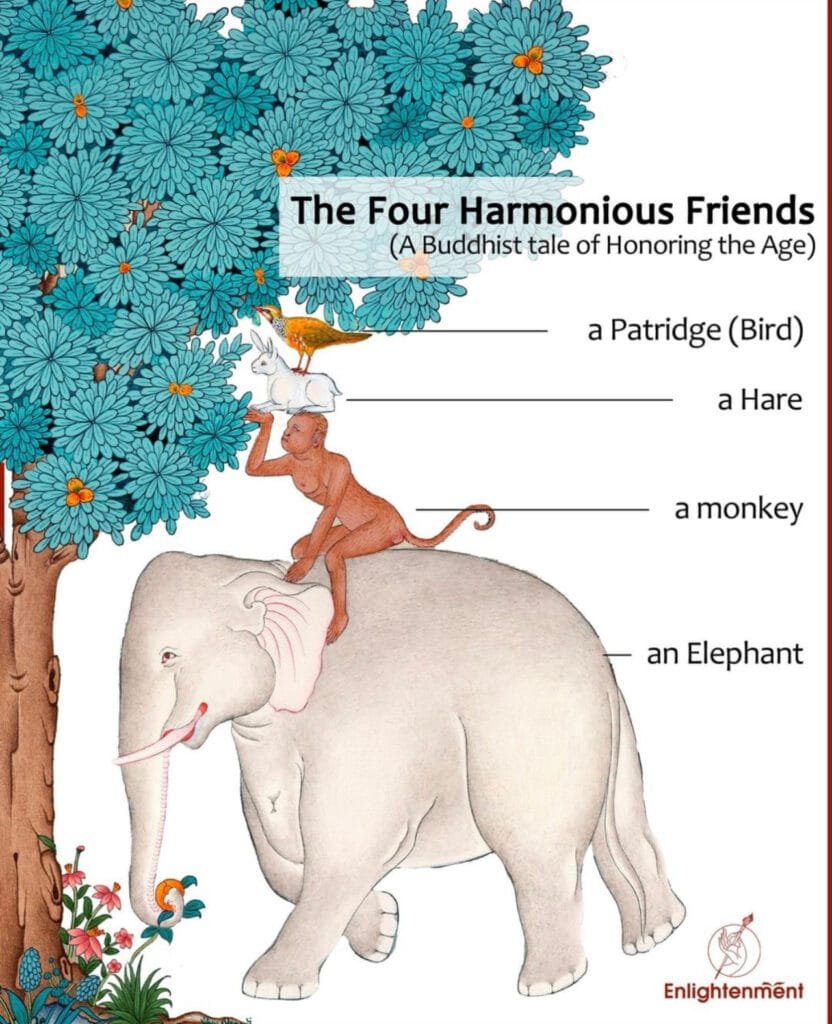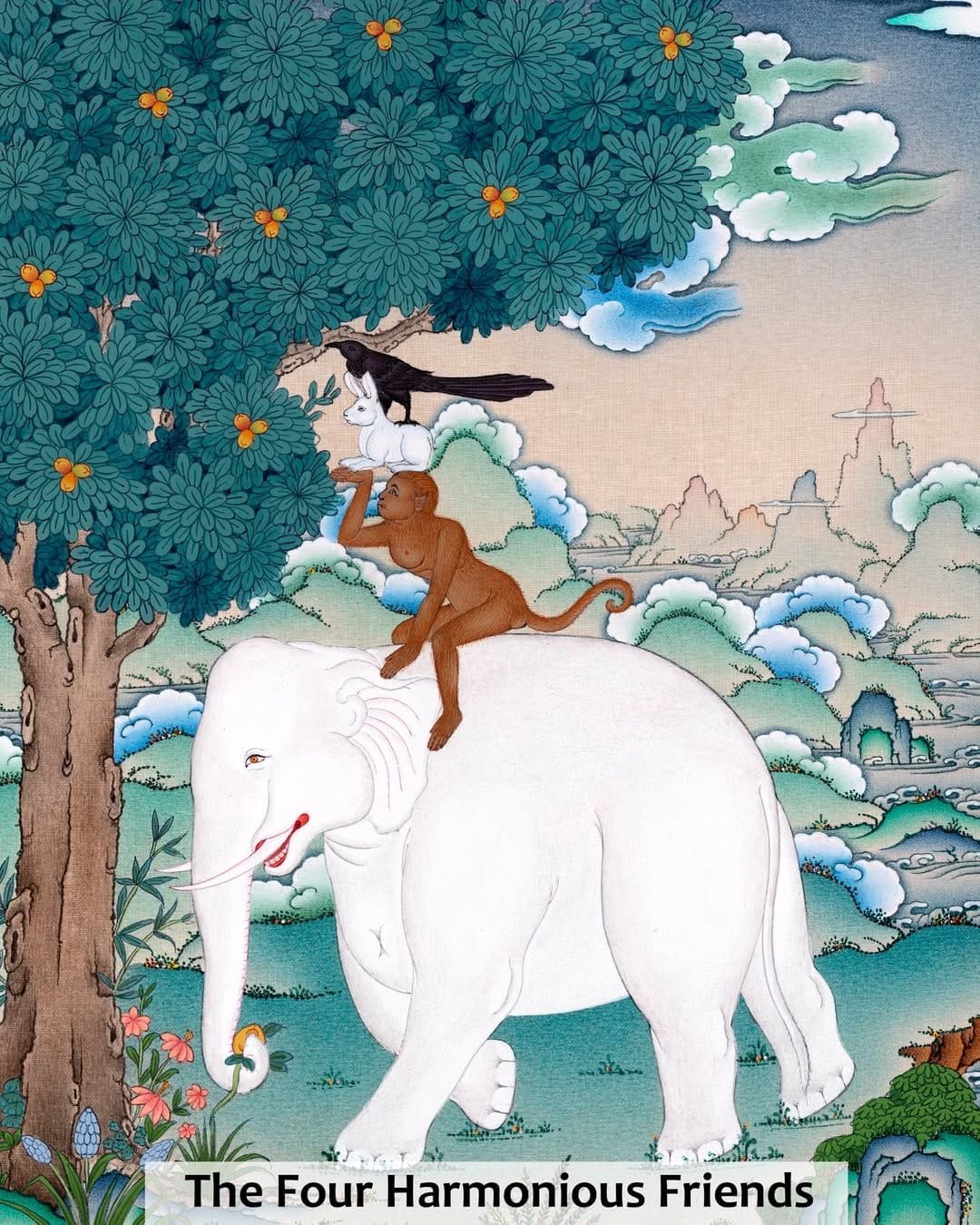Thangka, often referred to as the “encyclopedia of Tibetan culture,” is a traditional Tibetan painting that intricately combines mineral pigments with delicate gold embellishments. These paintings encapsulate Buddhist teachings, mythological legends, and natural philosophy within a limited space. Among the diverse themes of Thangka art, animal motifs hold a special significance—not only as decorative symbols but also as profound representations of Tibetan values on life, nature, and harmony. From the “Four Harmonious Animals,” which symbolize mutual respect and cooperation, to the supernatural guardian beasts protecting the four directions, these animal depictions embody the core values of Tibetan culture, serving as cultural bridges between the past and the future.
The Four Harmonious Animals: A Symbol of Respect and Unity
The “Four Harmonious Animals” is a widely revered auspicious motif in Thangka art, featuring an elephant, monkey, rabbit, and partridge. These four animals are typically depicted in a pyramid-like composition, symbolizing harmonious coexistence, respect for elders, and mutual support. The origin of this imagery traces back to a Tibetan folk tale in which these animals evolve from conflict to cooperation.
According to the legend, the four creatures plant a fruit tree together and nurture it until it grows into a towering tree laden with ripe, delicious fruits. However, when the time comes to harvest, they argue over who should claim the fruit. Since the tree is too tall for any of them to reach alone, they ultimately decide to work together: the monkey stands on the elephant’s back, the rabbit climbs onto the monkey, and the partridge perches atop the rabbit’s head. Through cooperation and trust, they successfully pluck the fruit and share it among themselves, highlighting the values of unity and teamwork.

Symbolic Meanings of the Four Animals
1. The White Elephant – Strength and Stability
In Tibetan culture, the elephant represents the earth, signifying stability, strength, and wisdom. With its majestic and calm demeanor, the elephant also embodies prosperity and spiritual merit.
2. The Monkey – Intelligence and Agility
The monkey, known for its energetic and playful nature, symbolizes intelligence, adaptability, and wit. It is often depicted as an emblem of quick thinking and strategic problem-solving.
3. The Rabbit – Purity and Swiftness
The rabbit, gentle and nimble, represents alertness, speed, and purity. It is also a symbol of peace and tranquility, embodying a serene yet watchful spirit.
These animal figures in Thangka paintings not only enrich Tibetan Buddhist art but also convey deep philosophical lessons on harmony, respect, and cooperation—values that continue to resonate across generations.
4. The Partridge – Freedom and Harmony
The partridge, depicted with its wings spread wide, symbolizes freedom and flight. In Tibetan art, it embodies the ideals of peace, harmony, and liberation, completing the symbolic unity of the Four Harmonious Animals.
The Four Guardian Beasts: Cosmic Balance and Auspicious Power
Beyond the “Four Harmonious Animals,” Thangka paintings also feature another significant group of sacred creatures known as the “Four Guardian Beasts.” This set includes the Dragon, Garuda, Tiger, and Snow Lion, each representing a cardinal direction and a season, symbolizing harmony and order within the universe.
The “Four Guardian Beasts” are often depicted at the four corners of the Wind Horse (Lungta) on Tibetan prayer flags, which are used in religious ceremonies to invoke blessings and spiritual protection. As the prayer flags flutter in the wind, the images of these mystical creatures appear to dance, carrying prayers and auspicious energy into the world. These sacred beings are also frequently portrayed in Thangka paintings, sculptures, and other Tibetan artistic expressions, adding depth and symbolic richness to the culture.
Symbolic Meanings of the Four Guardian Beasts
1. The Dragon – The Essence of the East and Spring
In Tibetan culture, the dragon is considered a divine and powerful being, representing the East and the season of spring. Traditionally depicted in shades of blue or green, it signifies the renewal of life and the beginning of cycles. The dragon in Thangka art is often portrayed as a sinuous, agile figure, exuding an aura of mysticism and strength, as if ready to soar into the heavens.
2. The Garuda – The Spirit of the South and Summer
The Garuda, a mythical golden-winged bird, embodies the South and the energy of summer. Often painted in red, it symbolizes youth, vitality, and divine grace. In Tibetan mythology, the Garuda is seen as a celestial being, its radiant feathers and powerful wings representing the ability to transcend earthly limitations.
3. The Tiger – The Guardian of the West and Autumn
The tiger, associated with the West and the season of autumn, is depicted with striking yellow-striped fur. It represents raw strength, determination, and authority. In Tibetan art, the tiger is often portrayed in a regal stance, its fierce gaze exuding power and courage, making it a formidable guardian.
4. The Snow Lion – The Protector of the North and Winter
The Snow Lion symbolizes the North and the season of winter. Often depicted in white or black, it represents both death and rebirth. In some interpretations, the Snow Lion replaces the Black Tortoise (often seen in Chinese cosmology) and is associated with northern rock formations or snow-covered mountains. Its strong, majestic form, with flowing fur and a fierce yet noble expression, embodies both strength and spiritual purity.
Together, these Four Guardian Beasts form an essential part of Tibetan artistic and spiritual traditions, conveying the profound wisdom of cosmic balance, protection, and auspicious energy.
Other Animal Symbols in Thangka: Auspicious Meanings
Beyond the Four Harmonious Animals and the Four Guardian Beasts, Tibetan Thangka paintings feature numerous other animals with auspicious meanings, such as the golden fish, conch shell, deer, and horse. Each of these animals carries profound symbolic significance in Tibetan culture and Buddhist philosophy.
1. The Golden Fish – Harmony of Compassion and Wisdom
In Thangka art, the golden fish are often depicted in pairs, playfully swimming together, symbolizing the perfect union of compassion and wisdom. Their graceful movements in water represent freedom and fearlessness, embodying the harmonious balance between intellect and benevolence.
2. The Conch Shell – The Sound of Dharma
The right-turning conch shell represents the cosmic rotation and is a symbol of the spreading sound of the Buddha’s teachings. Intricately detailed in Thangka paintings, the conch shell’s spiraling form seems to echo the divine resonance of Buddhist mantras, guiding practitioners on their spiritual journey.
3. The Deer – Longevity and Peace
Deer are symbols of longevity and happiness. Often depicted in serene forest settings, their gentle and elegant demeanor exudes a sense of tranquility. In Buddhist iconography, a pair of deer flanking a Dharma wheel represents the Buddha’s first sermon in Sarnath, where he set the Wheel of Dharma in motion.
4. The Horse – Spirit of Freedom
The horse symbolizes strength, speed, and boundless freedom. In Thangka art, it is often shown galloping with vigor or rearing its head in a powerful stance, representing untamed energy and an unyielding spirit. The Wind Horse (Lungta), a central figure in Tibetan prayer flags, carries prayers and good fortune as it soars through the skies, bringing prosperity and positive energy.
From Tradition to Modern Inspiration: Contemporary Thangka Animal Art
With the evolution of artistic expression, modern Thangka artists have embraced innovation while preserving the essence of traditional Tibetan symbolism. They incorporate these vibrant, lifelike animal elements into contemporary designs, adapting them for modern industrial production and aesthetic preferences.
Modern Applications of Thangka Animal Symbols
- Auspicious Four Harmonious Animals Metal Badges
Inspired by the Four Harmonious Animals (elephant, monkey, rabbit, and partridge), these metal badges refine their traditional forms into elegant, stylized designs. With a balance of modern color schemes and classic Tibetan motifs, these badges serve as both decorative accessories and cultural tokens, allowing people to carry the essence of Thangka art wherever they go. - Four Guardian Beasts Metal Badges
Featuring the Dragon, Garuda, Tiger, and Snow Lion, these badges reimagine the powerful guardian creatures with a sleek, minimalist aesthetic. This fusion of ancient mythology and modern craftsmanship breathes new life into Tibetan symbols, making them more accessible to contemporary audiences.
The Timeless Wisdom of Thangka Animal Symbols
In Thangka, animals are not merely decorative elements; they serve as cultural and spiritual messengers. Through their artistic beauty, they convey the Tibetan people’s deep reflections on life, nature, and faith.
Their symbolism offers timeless lessons:
- Like the Four Harmonious Animals, we should embrace mutual support and cooperation.
- Like the Four Guardian Beasts, we should protect harmony and balance in our world.
- From the goldfish, we learn about freedom; from the conch, wisdom; from the horse, the spirit of perseverance.
Thangka reminds us of the Tibetan tradition of merging faith with art. As cultural emissaries, these animals infuse human civilization with profound spiritual strength. In our fast-paced world, they inspire us to reconnect with nature, faith, and the beauty of life—drawing wisdom from ancient traditions to enrich our modern existence.








